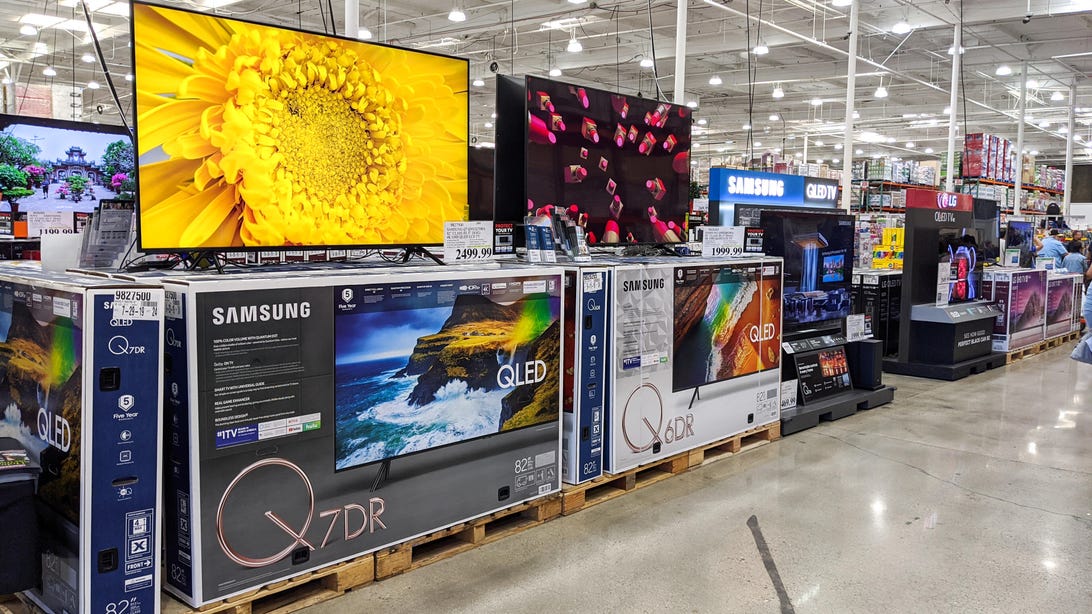TV prices hit a 9-year high, but what does this mean for your Black Friday shopping?

Don’t worry TV shoppers, big-screen sales will still happen this fall.
Geoffrey Morrison/CNET
The holiday buying season is nearly upon us and TV shopping is about to kick into high gear again. This time of year TV prices typically fall — dramatically — as retailers and manufacturers compete for your big-screen dollar. But there’s something different about TVs in 2021, and I’m not talking about 8K resolution, OLED versus QLED or the latest streaming features.
“Pricing right now on TVs is the highest since at least 2012,” says Stephen Baker, vice president of industry analysis at NPD group. “Holiday pricing overall is likely to be at least $100 above normal. Last year the average price of a TV was $363 during the fourth quarter, which is fairly typical over the last few years. This year our forecast is for the average price to be approximately $500.”
For many shoppers, a $500 TV sounds pretty affordable, but that’s the average of every TV sold in the US. The majority are entry-level models with small screens and modest features that bring down the average. A glance at Amazon’s list of best-selling TVs, for example, reveals most models in the 32- to 43-inch range with prices well below $500.
TVs come in a wide range of prices and sizes, and the higher average selling price will impact smaller, cheaper models more than larger, more expensive ones. In fact, high-dollar TVs are selling better than ever, which of course helps drive up the average price. “Sales of TVs over $1,500 are at record levels, and sales of TVs 75-inch and above are performing much better than the overall market,” says Baker.
The quick takeaway? If you’re in the market for a cheap TV, prepare to pay more than in the recent past. Conversely, there should be plenty of good deals on midrange and higher-end models. Let’s take a closer look at why.
Read more: Black Friday pricing comes early: TCL 6-Series TVs on sale starting at $700

Shipping costs are up substantially this year, helping drive TV prices higher.
Port of Oakland
Chips, ships and automobiles
Just like other technology segments, such as cars, the components that go into TVs are more expensive this year. Several manufacturers I asked pointed to the chip shortage and the costs of LCD panels and other guts, but another big factor was the higher cost of shipping.
“We are seeing higher prices across all sizes and technologies compared to this time last year,” says Chris Larson, senior vice president for TCL North America. “Semiconductors, copper, chemicals, glass, plastic, LCD panels and freight (both ocean and inland) are all up significantly.”
Issues with the global supply chain, a complex system that transports products around the world, have intensified during the pandemic and will continue throughout the holidays. Recently President Joe Biden announced that the port of Los Angeles would start operating 24/7 to help deal with the shipping backlog. Because they’re large products, TVs generally arrive in the US by ship, and the increased shipping costs are passed along to buyers.
“In 2021, things like panel costs have begun to level off, what we’re seeing now is an increase in freight costs,” says Laynie Newsome, chief sales officer at Vizio. “Container and vessel shortages have caused ocean shipping prices to quadruple over the past year.”
Read more: You shopped like never before. The supply chain couldn’t handle it
The good news? Inventory this holiday season likely won’t be a problem. “Right now we don’t expect significant shortages in TVs,” says Baker. “While the port blockages are a concern, there are a lot of choices in the TV market. So if consumers can be flexible around brand and screen size, availability should be sufficient.” He adds that over the last few months TV sales have been tepid, which allows TV-makers to build up enough inventory to deal with the holiday rush.
The TV-makers we interviewed said they didn’t anticipate problems fulfilling demand, despite the supply chain issues, although there’s more uncertainty than usual this year. “While we are working hard to meet consumer demand,” said Shoji Ohama, head of the TV and projector business at Sony Electronics. “There are still many unknowns with supply chain and inventory as COVID-19 evolves and continues to have an impact.”

Sales on TVs are showing up earlier than ever.
David Katzmaier/CNET
Want a new TV this year? Relax, there will be deals
So what does all of this mean for TV shoppers? Traditional holiday price drops will still happen, but maybe those $100 doorbuster deals won’t be as common.
“There will be price drops, there will be promotions, the calendar does not disappear,” says Baker. “But all of those pricing activities will happen on products priced substantially higher than in previous years.” In other words, midrange and higher-end TVs, the ones selling at a historic clip, are still likely to see plenty of price reductions in the next couple months. In fact, some are happening already.
My favorite high-end TV of the year, the LG C1 OLED, had its first major price drop at the end of September. That’s earlier than ever for LG, and the drop was significant. The 65-inch model is now $1,800, which is already less expensive than its predecessor last year.
PSA: The LG C1, my favorite high-end TV this year for the money, just got its first big price cut at major retailers today. 65-inch down to $1800 (a $300 drop), which is $100 cheaper than the 2020 65-inch CX’s lowest price. https://t.co/AZXdeOtJ3k
— David Katzmaier (@dkatzmaier) September 27, 2021
A more recent example is my favorite midpriced TV, the TCL 6-series, which got its holiday price drop in mid-October. The 65-inch model is now $1,000. That’s $100 higher than its all-time low during the holidays last year, but still an excellent deal. Could it go lower for Black Friday? Maybe, but I wouldn’t bet on it.
Despite supply chain issues and chip shortages my advice remains the same as it’s been in past years: Now through Black Friday and Cyber Monday is the best time to buy a new TV, and if you see a deal on one you like that’s in your price and size range, pull the trigger. Then you can relax and go back to worrying about the important things in life, like what to watch on that big new TV.
CNET will be tracking deals all season and we’ll point you toward the best ones on TVs and everything else. Stay tuned!
For all the latest world News Click Here


